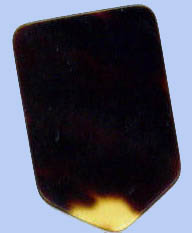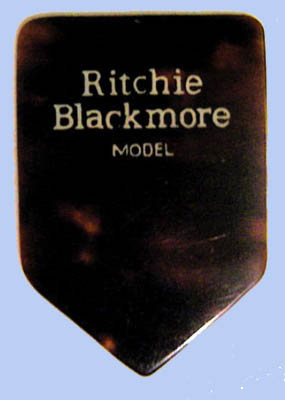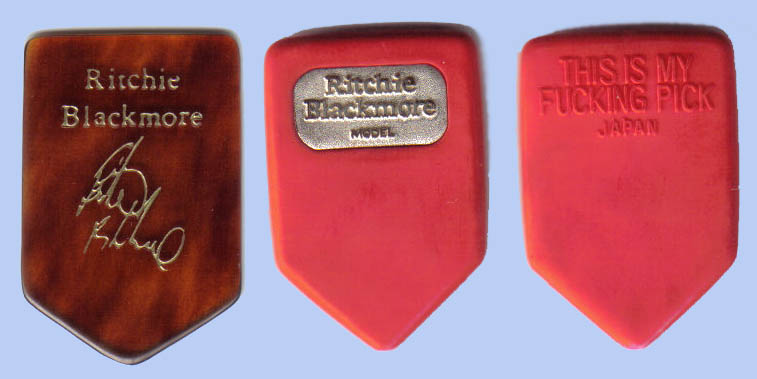|
Ritchie Blackmore Picks - Real or Myth Ritchie Blackmore – Richard Hugh Blackmore (born in 1945) probably one of the strangest men in rock music. Although lately he has thrown himself into his medieval music with his wife, he consistently appears as one of the most in demand players. Chuck Kirby's articles will sort the fact from fiction in relating to his picks and you will get to see many rare examples. The example shown is my "real" tortoiseshell pick which I got from one of his entourage along with the other Blackmore pick in the previous article. Picks - Real or Myth Vol I The guitar picks attributed to Ritchie Blackmore conjure up all manner of speculation and anecdotal evidence, some of which is reliable and some of which is at best, dubious. Beginning here, in a series of articles, I will attempt to unearth little known facts and bring them to light to pick collectors that may find it intriguing and challenging to obtain picks owned by Ritchie Blackmore, or associated with him in a direct or even indirect manner.  Blackmore is most known for his use of a 5 sided pick that is heavy gauge and made of genuine tortoise shell and is commonly known as a "home plate" shaped pick. These picks have nothing whatsoever printed on them on either side. For those that have knowledge of the mostly American game of baseball, the home plate is a pentagonal shaped slab made of hard rubber material and is located at the starting point of a baseball diamond. It resembles a shield as well from times past as used by warriors engaged in mortal combat.
Blackmore is most known for his use of a 5 sided pick that is heavy gauge and made of genuine tortoise shell and is commonly known as a "home plate" shaped pick. These picks have nothing whatsoever printed on them on either side. For those that have knowledge of the mostly American game of baseball, the home plate is a pentagonal shaped slab made of hard rubber material and is located at the starting point of a baseball diamond. It resembles a shield as well from times past as used by warriors engaged in mortal combat.As a matter of fact, I found in my research that this shape is well known to British guitar players and pick collectors as "the Bert Weedon shield shape". Bert Weedon was born in England in 1920 and today at 88 years of age, still finds some time to play the guitar and for many years, his picks have been made in the 5 sided shield shape as well as a shield shape with more rounded sides. The first time that this shape was probably seen was in the 1928 D'Andrea catalog which was partially reproduced in Will Hoover's book on vintage picks entitled Picks! The first time I saw a Blackmore pick was in the July 1975 issue of Guitar Player magazine. A feature writer for the magazine at that time was Steve Rosen who had a small collection of picks that were mostly generic, with a few custom printed ones mixed in. He displayed them on one full page of the magazine with some brief notes on each pick and how he obtained them from the artist. Seen among some of the most famous players that included Hendrix, Clapton and others, near the bottom is an almost transparent pick in the familiar shield shape that Rosen got directly from Blackmore. There is no mention of the material that it is made of, but it is assumed it was real tortoise shell. Rosen only said that Blackmore gave him the pick that was fairly hard and he described it as "rocket shaped". I have attempted unsuccessfully for years to contact Steve Rosen about this pick, and only recently may have gotten a lead as to how to contact him, so if I do, any information I gather can be included in an upcoming installment in this series. In the late '70's during Blackmore's period in his band Rainbow, he did an interview for a popular music publication in which he was asked about his unique guitar picks. He only stated that he had used that type and shape of pick since he was 11 years old and that it suited his style the best. He did not mention the exact type of material or how or where he had them made. There are numerous stories that have circulated through the years about Blackmore's reluctance to give any elaboration on the origin of his picks and he has been loathing at times to hand them out to fans. By some accounts, he has become quite irritated and even angry at his staff or crew members when they have inquired about his picks, which has fueled speculation about them and added a degree of mystery. After many years of research, I was fortunate to have direct contact with Stuart Smith, a friend and student of Blackmore who is a great guitar player in his own right and leader of his band, Heaven and Earth. Stuart confirmed that the picks that Blackmore uses are genuine tortoise shell and originate in Japan and are usually made by the Pickboy company. He did not however confirm that Blackmore has always had all of his tortoise picks made by Pickboy, only that they have come from there at times, but that they originate in Southeast Asia. It is possible that Blackmore has attempted to shroud the origin of the picks in secrecy due to the fact that the use of tortoise shell in products has been banned in many countries in the world including the US. Whatever the true reasons are for the aura of mystery surrounding Blackmore's picks, he and those around him have possibly perpetuated this unintentionally through the years which has made them highly sought after among collectors of rare picks and has also led to much more speculation about the many picks that bear his name or signature in some way that are considered promotional only. In the past 5 years or so as Blackmore has toured with his latest band, Blackmore's Night, a crew member reports that they start a tour with around 10 of the tortoise picks in a box and Blackmore uses them during the show and afterwards they are returned for safe keeping to the box and are not handed out to fans. On these tours, crew members sometimes hand out promotional picks of which I will cover in a later issue. This time, the topic is confined to only the picks that Blackmore actually uses, which are the infamous "home plate" shaped tortoise picks that have no printing on them. Next time, I will continue to discuss tortoise shell picks associated with Blackmore and elaborate on their history and origins and how they have mistakenly been assumed to have been used by this unique and gifted guitar player. Picks - Real or Myth Vol II The saga of the guitar picks that are attributed to Ritchie Blackmore will now transition to the myriad of models that are not only made of genuine tortoise, but numerous other materials not quite as exotic, being nonetheless of great interest as rumors and speculation drive the value of any pick with his name printed on it.  In this installment however, the discussion will be limited to genuine tortoise picks that are imprinted by various means and methods. As previously stated in my first installment in this series, Pickboy by far made most of Blackmore's non printed "home plate" shaped picks in genuine tortoise and in the late '70's the company began making genuine tortoise picks to be sold to the general public in Japan at guitar shops, music stores and the like.
In this installment however, the discussion will be limited to genuine tortoise picks that are imprinted by various means and methods. As previously stated in my first installment in this series, Pickboy by far made most of Blackmore's non printed "home plate" shaped picks in genuine tortoise and in the late '70's the company began making genuine tortoise picks to be sold to the general public in Japan at guitar shops, music stores and the like.The first examples of these picks were simply adorned with white print in an older typewriter style font of the day with the "R" and "B" of Blackmore's first and last names capitalized and the remaining lettering was in lower case. Below his name which was printed on two lines was the word "MODEL" printed in all caps, but several points smaller than that of his name. They were blank on back and these picks were made for a number of years into the early '80's and many were sold to guitar players in Japan and used up like any other pick and tossed aside when worn out. They were represented as being identical to the picks that Blackmore used, so Blackmore fans could buy them and feel confident that they were using the exact same pick that the master himself used. Some later examples did have a gold sticker adhered to the back that reads as "Pickboy Japan" in Japanese kanji and these are slightly harder to obtain than those without the sticker. Genuine tortoise does not come cheap, even in Japan, so other types of printed picks were produced by Pickboy at that time and will be covered in a later installment. Throughout the mid and late '80's, numerous types of genuine tortoise picks made their way into fans hands that were made by Pickboy and printed in various colors of ink and different fonts. During this era they opted to print Blackmore's initials, "RB" in caps in either white or gold ink. Various styles of fonts were employed as well as various sizes. Most were in simple block lettering, but one type was slightly more decorative and typically seen in gold print, and even more rare, there is a version of this pick that is simply engraved with "RB" without print color. The only genuine tortoise pick to bear Blackmore's signature printed on it is the pick that was released to the general public in Japan in about 1994 and has Blackmore's full name printed near the top in the old typewriter style font of the late '70's with Blackmore's signature directly below it. These picks always came with gold printing and were usually blank on the back and their desirability skyrocketed after one appeared in the Guitar Player magazine pick poster released in the magazine in 1994 as part of the Jas Obrecht collection. Obrecht was a long time writer and senior interviewer with the magazine and had amassed an amazing collection of custom and generic picks through the years from famous guitar players he had interviewed. It was assumed for many years that Blackmore used these picks with his signature on them, but sources through the years in the Blackmore camp continued to state as Blackmore did, that he had no custom picks with his name or signature printed on them that he actually used. To this day, Blackmore vehemently denies ever having any custom picks made for his use. Worth noting also in regard to the signature tortoise pick is that many believed in the '90's that they came in limited numbers in the Japanese release of the Deep Purple CD "Come Hell or High Water". I have spoken to several top Blackmore collectors in Japan about this claim and all say that this was untrue. None ever saw that particular pick in a CD, but they all said they saw them sold in music and guitar shops throughout Japan. To this day, this is debated and there are people that claim that they got one from a CD. I cannot definitively disprove such claims, but I can offer a very plausible theory that supports the hypothesis that these picks were never included in a CD. The CD and DVD of the same name consisted of audio and video recordings taken from shows in Germany and England in October and November of 1993. Blackmore quit the band soon afterward following a show in Finland on November 17th and Joe Satriani was asked to step in and complete the tour. The CD and DVD were not released until nearly a year later in 1994 and I think it's highly unlikely that a pick with Blackmore's name imprinted on it would have been allowed in the packaging by the other band members that clearly made their displeasure with him known in interviews contained in the DVD. One final note on this pick is that at some time around 1994, Pickboy manufactured a small number of these picks with the gold Pickboy sticker on the back. These are more rare, thus more desirable. Before I conclude my discussion of all of the various attributes associated with the genuine tortoise picks, I would like to point out that are also some inconsistencies in the shape of the picks. All are indeed the 5 sided "home plate" shape, but there are variances in the lengths and angles of the points. There has even been seen some slight variances in the gauge, but very nominal. Concerning gauge, nearly every tortoise pick is about .90mm-1.00mm in thickness. This is considered a heavy gauge pick and all of the picks that Pickboy made were pretty consistent with this thickness. However, it has been said by reliable sources in Japan that while there on tour in years past, Blackmore was known to run low on picks at times and a tech would actually make tortoise picks for him out of a thin sheet of polished tortoise shell. The quality was very high and nearly identical to the manufactured picks by Pickboy, but slight differences could be seen in shape and gauge. Ultimately, two distinct shapes are commonly seen as can be seen in the scans for this article. One shape is longer and the tip is more blunted, while the other common shape is slightly shorter and the tip is more pointed. Not only the printed Pickboy picks have come in these two shapes over the years, but also the blank picks that Blackmore actually uses. I have not been able to pinpoint the tours or years that each shape was used, but one could surmise that possibly Blackmore used the same shape that corresponded to the times that the printed picks were being made and sold to the public by Pickboy. This is pure speculation and I hope to eventually determine the reason behind this minor variation in the "home plate" shape theme. This brings us to the end of our discussion of genuine tortoise picks in the "home plate" shape that were imprinted by the Pickboy company with Blackmore's name or his initials on them. It seems that there is always something new and interesting to learn about Blackmore's picks, so I welcome any feedback on this information in both praise or criticism as well as any new facts that I didn't cover in the first two installments of this series on Blackmore's genuine tortoise picks. Next time, we will take a good look at picks that are not made of tortoise, but are printed with Blackmore's name on them and continue to be highly sought after regardless of the fact that Blackmore claims to have never owned any of them. Picks - Real or Myth Vol III  We have now come to the point in which we will delve further into the arcane lore of Ritchie Blackmore's picks by examining picks that have been made through the years that bear his name or band name and are not made of genuine tortoise. For the previous two installments, our discussion was confined to picks made of genuine tortoise, both printed and non printed. That encompassed both promotional and those used by the man himself. Our quest now takes us into the area of the promotional pick that comes in a much wider variety of materials as well as colors and origins of manufacture. The home plate shape remains prevalent throughout, but in recent times, even standard shaped picks have emerged. © Chuck Kirby Chuck Kirby is a long time music aficionado and guitarist whose earlier influences included Jimi Hendrix, Ritchie Blackmore and Uli Jon "Ulrich" Roth. His musical preferences are neo classical shred, metal, and progressive power metal. Chuck has been collecting guitar picks since 1978, after receiving a Ted Nugent pick. He is a happily married architectural illustrator, living in North Carolina with his wife and daughter. |